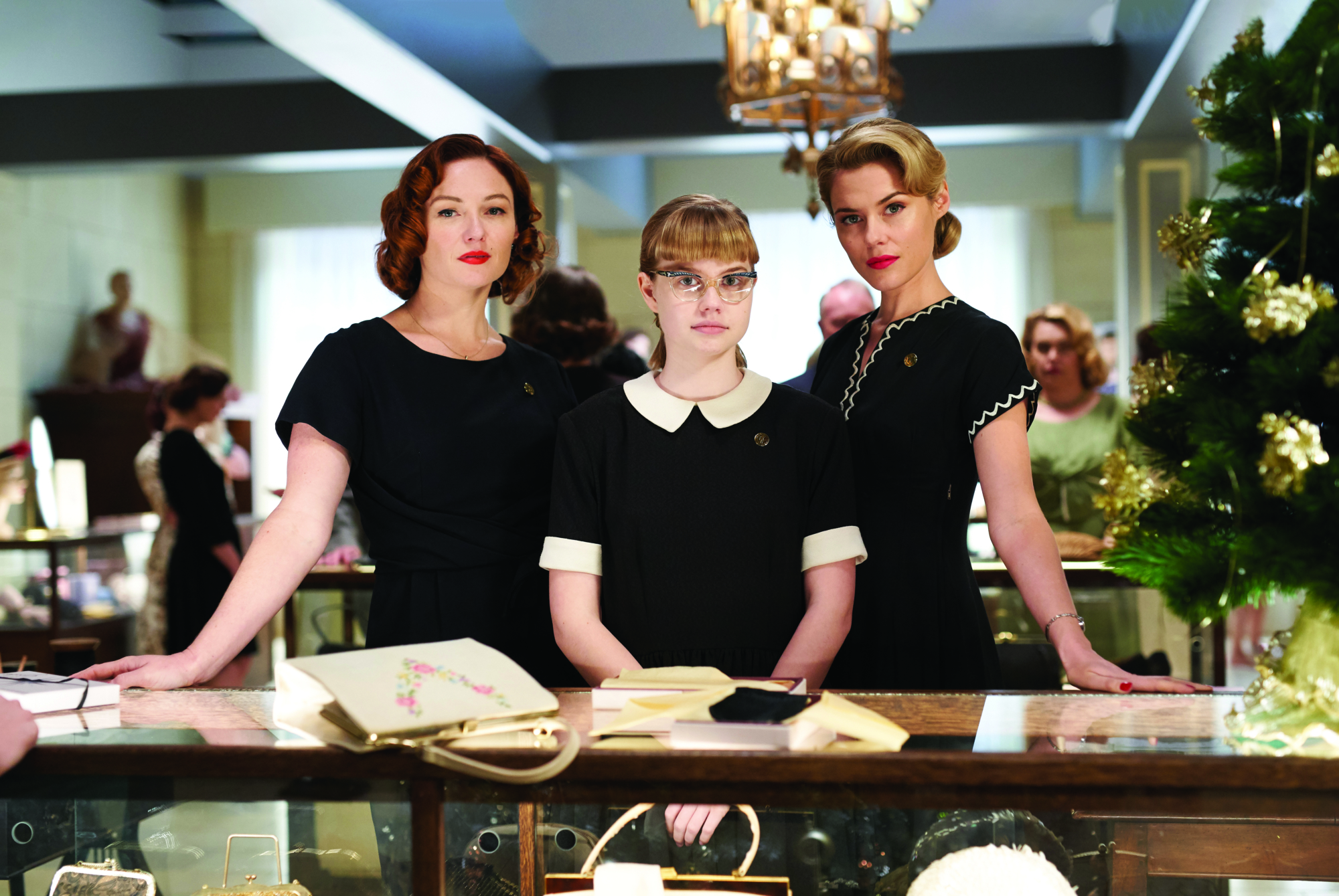Black absorbs meaning the way it absorbs light. In clothing, it’s the colour of authority and sophistication, secrecy and simplicity, grief and lust. It can be both bold and sober, making its wearers stand out glamorously or blend in discreetly.
In Bruce Beresford’s 2018 comedy-drama Ladies in Black, set in Sydney during the summer of 1959–1960, the titular characters are not merry widows or Gothic femmes fatales, but shop assistants at the fictional upscale department store Goode’s. While their work attire is designed to make them appear alike, this film is interested in the particularities of women’s identities and desires. Curiously, though, the charm of this deliberately quaint film depends on the smoothing away of rough edges. Ladies in Black raises social tensions – class inequality, sex-based double standards and suspicion of migrants – but only resolves them ‘magically’, through the twin forces of romance and consumer culture. Does this make the film’s nostalgic pleasures suspect?
From women to ladies: The genteel gaze
Ladies in Black is a personal project for Beresford. With his writing and producing partner Sue Milliken, he spent twenty-four years striving to bring to the screen the 1993 novel The Women in Black by Madeleine St John, an old University of Sydney acquaintance of Beresford’s from the early 1960s.[1]Garry Maddox, ‘Ladies in Black, a Love Letter to Sydney’, The Sydney Morning Herald, 6 September 2018, <https://www.smh.com.au/entertainment/movies/ladies-in-black-a-love-letter-to-sydney-20180828-p500cm.html>, accessed 24 October 2018.
Beresford explains, in a foreword to a 2009 edition of the novel, that the fastidious St John styled her writing after Jane Austen’s: ‘The palette is small, but the observation and the dialogue acute, touching and often very funny.’[2]Bruce Beresford, ‘Madeleine and Me’, in Madeleine St John, The Women in Black, Text Publishing, Melbourne, 2009 [1993], p. xv. He also reminisces about having introduced St John to American filmmaker Whit Stillman, whose work she admired.[3]ibid., pp. xvi–xvii. Stillman would go on to direct the richly hilarious Austen adaptation Love & Friendship (2016); it’s tempting to wonder what he might have made of The Women in Black. Instead, we have Beresford’s handiwork, fuelled by his relationship to the Sydney of this era.
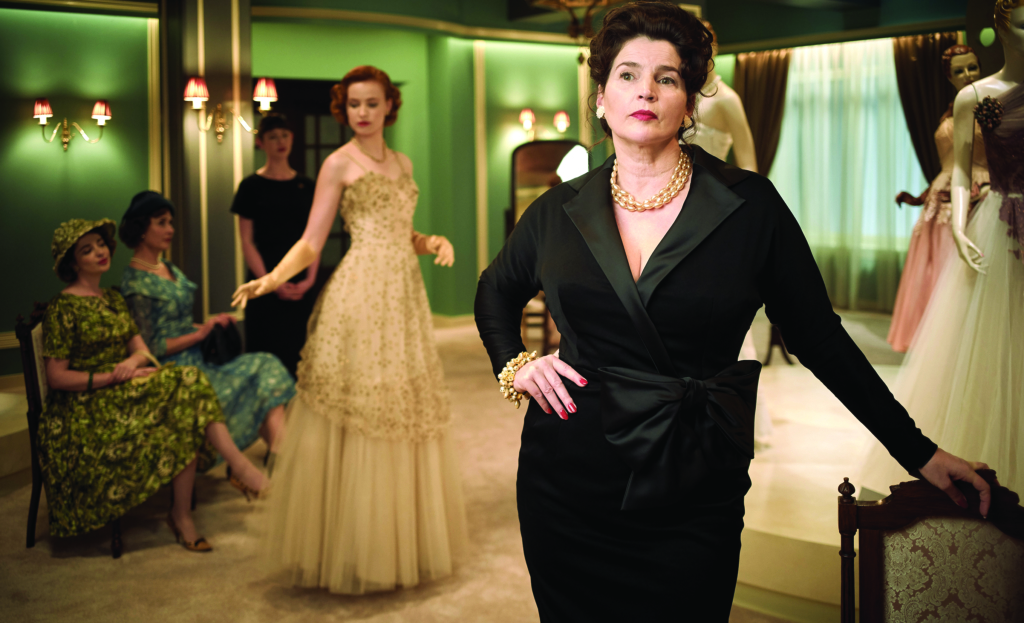
The first clue to what kind of film this is lies in the title change from ‘women’ to ‘ladies’.[4]While the title change originally happened in 2015, when Tim Finn adapted the novel for the theatre, Beresford and Milliken’s decision to retain it is nevertheless telling. Ladies in Black lacks the empathy with which its source novel chronicles the main characters’ diverse experiences of gender, and misses the affectionate irony with which St John observes their efforts to make themselves as women in the world. Beresford’s film is more concerned with gender’s outward semblance: a ‘lady’ is courteous, decorous, genteel and well socialised. His cinematic creation moves sleekly and incuriously from scene to scene and character to character, skimming their surfaces.
Ladies in Black raises social tensions – class inequality, sex-based double standards and suspicion of migrants – but only resolves them ‘magically’, through the twin forces of romance and consumer culture.
The coming-of-age trope is a time-honoured initiation into the social rules of gender – as evidenced by precursor texts such as Jane Eyre, Little Women and Disney’s princess canon, which dramatise the eventual ‘yielding’ of a female protagonist to adult society – and Ladies in Black affectionately indulges viewers’ expectations of this type of story arc. Clever, bespectacled school leaver Lesley Miles (Angourie Rice) takes a summer job at Goode’s as she awaits her exam results. A petit-bourgeois only child, Lesley is coddled by her mother (Susie Porter) and a source of bemusement for her father (Shane Jacobson). But, at Goode’s, seizing her first chance to claim an identity of her own, she gives her name as ‘Lisa’.
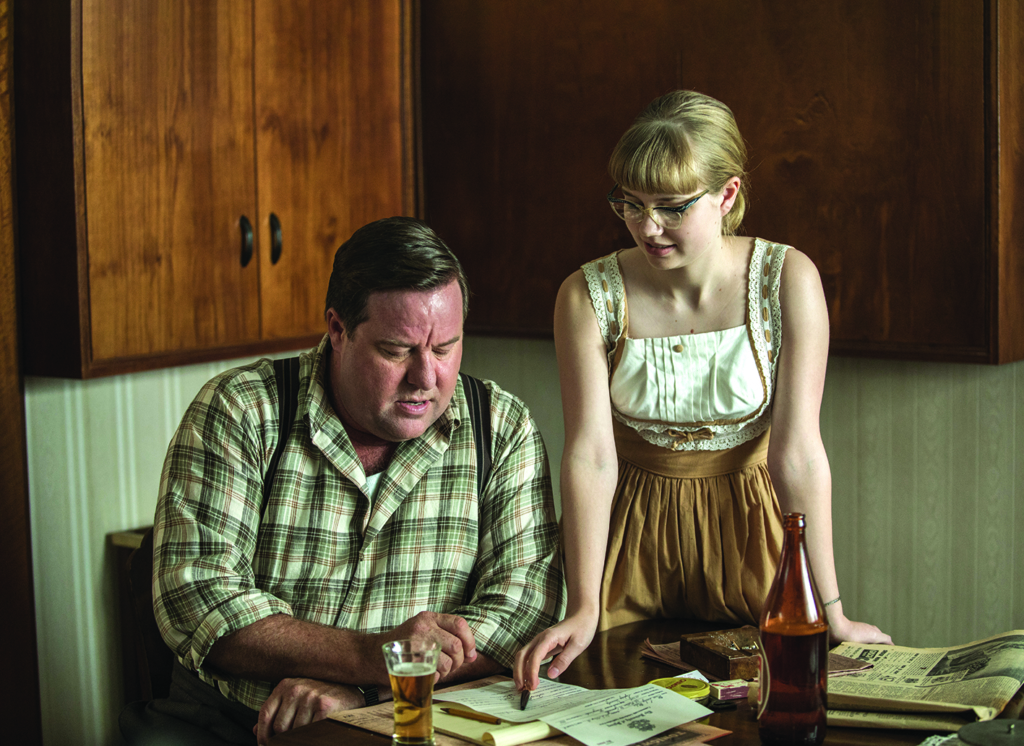
The store manager, Miss Cartwright (Noni Hazlehurst), assigns Lisa to the ‘Ladies’ Cocktail’ department, where she sells dresses alongside the unhappily married Patty Williams (Alison McGirr) and unhappily single Fay Baines (Rachael Taylor). But it’s Magda Szombatheli (Julia Ormond), the imperious manager of the couture nook known as ‘Model Gowns’, who exerts the greatest influence on Lisa. Compared to the fretfulness and rudimentary-home-sewing femininity of Lisa’s mother, Magda’s chic confidence moulds Lisa into a new kind of ‘lady’.
Magda invites Lisa to lunch at her glorious North Shore apartment, where the teenager meets Magda’s wry husband, Stefan (Vincent Perez), and their exuberant young friend Rudi Jánosi (Ryan Corr). In a few quick, practised gestures, like a fashion illustrator deftly sketching a silhouette, Magda gives Lisa a makeover. She encourages Lisa’s growing independence, and, while she sternly claims to be pragmatic and unsentimental, Magda nevertheless subtly steers her protégée towards the particular model gown that has captivated Lisa’s young heart: a girlish confection named, appropriately, ‘Lisette’.
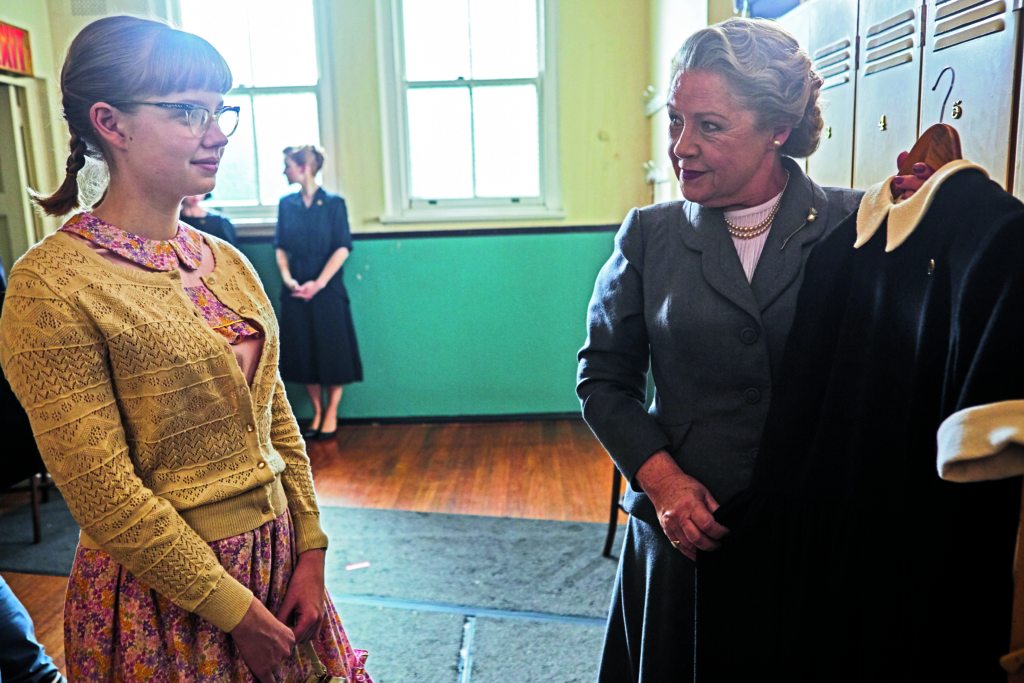
Because it is an Australian comedy concerned with fashion and identity set in the late 1950s, Ladies in Black was inevitably compared to The Dressmaker (2015) upon its release.[5]See, for example, Glenn Dunks, ‘Ladies in Black Is an Exquisitely Entertaining Story of Romance and Female Empowerment’, Flicks.com.au, 18 September 2018, <https://www.flicks.com.au/reviews/ladies-in-black-is-an-exquisitely-entertaining-story-of-romance-and-female-empowerment/>, accessed 24 October 2018. But, whereas director Jocelyn Moorhouse luxuriates in swooningly stylised visuals, showcasing the freewheeling couture pastiches of costume designer Marion Boyce (also known for her work on TV’s Miss Fisher’s Murder Mysteries), Beresford fails to convey the pleasures of clothing for the women who actually wear it; the camera slides dully over Wendy Cork’s costumes.
In the novel, Lisa’s yearning for the evening gown ‘Lisette’ is almost palpable, and her ill-fitting clothing is touching because it’s been made with love. Here, Mrs Miles’ childish, frou-frou frocks are unambiguously embarrassing, yet the corresponding reveal of ‘Lisette’ lacks dramatic heft because it is not framed or lit with the glamour it holds for Lisa. Beresford clearly doesn’t understand – as St John did – what it is to see oneself in a garment; Ladies in Black is full of genteel femininity, but lacks the deeper, more satisfying romance of self-identification through fashion.
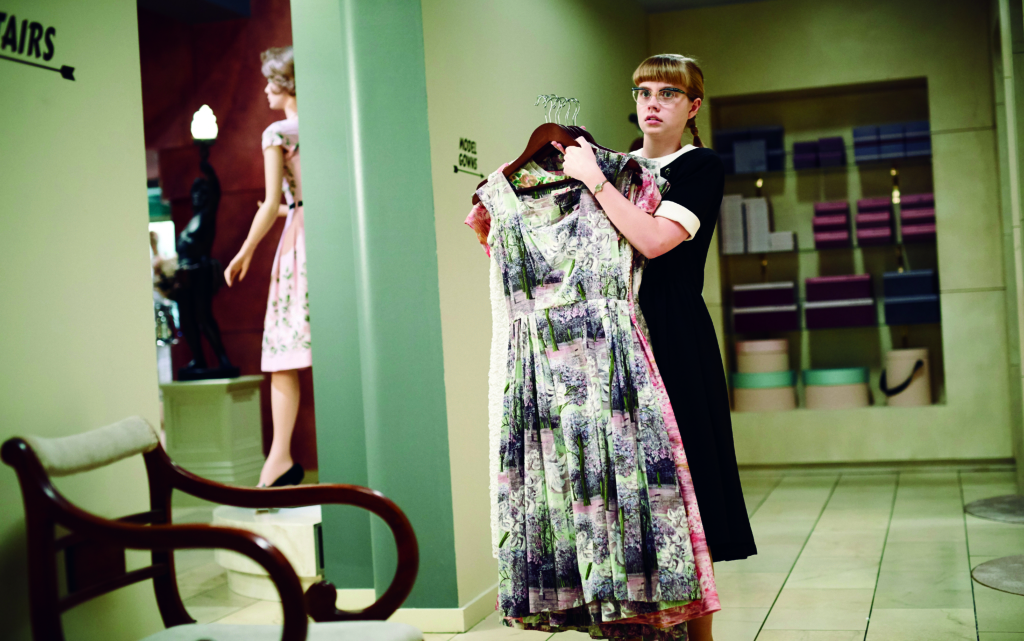
Consumption and cosmopolitanism
In nineteenth-century Europe, domestic servants frequently wore black dresses and suits. As the retail and hospitality industries swelled in industrialised cities, black also became the uniform for new kinds of maids and footmen: the shopgirls and waiters who provided deferential, self-effacing service to prosperous consumers.[6]Marc Bain, ‘Only Black Is the New Black: A Cultural History of Fashion’s Favorite Shade’, Quartzy, 4 February 2018, <https://qz.com/quartzy/1194798/only-black-is-the-new-black-a-cultural-history-of-fashions-favorite-shade/>, accessed 24 October 2018. By 1926, American Vogue was describing a Chanel ‘little black dress’ as a ‘Ford’, after car manufacturer Henry Ford’s quip that his Model T came ‘in any colour … so long as it’s black’.[7]See Dame Zandra Rhodes with Sonnet Stanfill, ‘Why Is the Little Black Dress a Fashion Icon?’, iWonder, BBC, <http://www.bbc.co.uk/guides/z2y4v4j>, accessed 24 October 2018. Much as Ford’s streamlined production methods revolutionised manufacturing, the mid-nineteenth-century advent of the department store had profoundly changed the relationship between shoppers and merchandise.
Shopgirls in popular culture have historically been stereotyped as social-climbing seductresses, only a rung or two above sex workers. Yet the gentility of the department store transformed its female staffer into a modernist ingenue, whose place at the heart of consumer culture not only enabled romances with rich customers, but also, more importantly, actualised her own authentic self.[8]See Ruth La Ferla, ‘Love for Sale: The Shopgirl Has a Pop Cultural Moment’, The New York Times, 16 December 2015, <https://www.nytimes.com/2015/12/17/fashion/love-for-sale-the-shopgirl-has-a-pop-cultural-moment.html>, accessed 24 October 2015. The department store, in turn, was portrayed as a site of cultural hybridity, in which new, socially progressive identities could be negotiated through the act of consumption. For example, in Brooklyn (John Crowley, 2015), which is also set in the 1950s, shy Irish immigrant Eilis Lacey (Saoirse Ronan) is working in Bartocci’s, an American department store, but struggles with homesickness. Much as Magda guides Lisa, Eilis’ supervisor, the stylish Miss Fortini (Jessica Paré), helps Eilis buy a new green swimsuit from Bartocci’s, with which she wows her Brooklyn beau, Tony Fiorello (Emory Cohen), on an excursion to Coney Island. Later in the film, the same swimsuit appears cosmopolitan when Eilis wears it during a trip home to Ireland; American in cut but Irish in colour, it dramatises Eilis’ hybrid cultural identity. Ultimately, Eilis’ sartorial self-transformation isn’t instrumental – a tactic to land a husband – but a means to better understand and express herself.
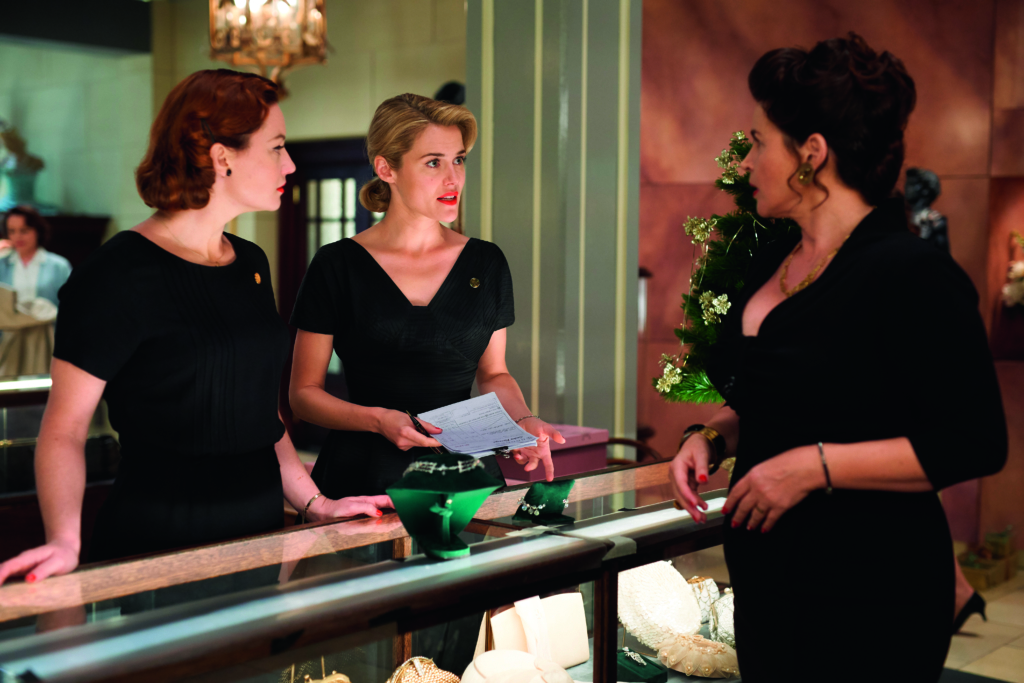
Accordingly, in Ladies in Black, Goode’s becomes a space for longing and abundance, its merchandise promising a better life to both staff and customers. Importantly, these garments are also erotically charged, allowing women to dress themselves in their desires. However, as we’ve seen, Lisa is denied her own agency when entering womanhood by Beresford’s bungling of her desire for ‘Lisette’, and the film additionally clamps down on the romantic possibilities of her friendship with Michael Foldes (Jesse Hyde), a second-generation Hungarian-Australian. While women’s bodies in this film are made to signify gentility, Europe – or, at least, the Australian-born characters’ conception of it – operates as an agent of cosmopolitanism. Perhaps it’s appropriate, then, that Magda’s accent wanders; Ormond seems to have stepped straight off the set of cult 1960s-set TV series Mad Men, in which she plays an insouciant French-Canadian matron. Fay and Patty dismissively call Magda a ‘continental’ and a ‘reffo’ (short for ‘refugee’); nominally Slovenian, she lays claim to a pan-European cultural sophistication that these naive Sydneysiders treat suspiciously but are ill equipped to challenge.
By contrast – and perhaps partly due to Taylor’s wooden acting – Fay seems blank and unformed. Dissatisfied with the boorish Aussie blokes she meets on double dates with her showgirl friend Myra (Celia Massingham), Fay wants the kind of love she can’t explain, let alone pursue. She listens dreamily to romantic music and, after she borrows Lisa’s copy of Leo Tolstoy’s novel Anna Karenina more out of politeness than interest, it leaves her sobbing.
When Rudi tells Magda he wants to marry ‘a nice Australian girl’, Magda’s knowing eye alights on Fay, whom she casually invites to a New Year’s Eve party at her apartment. Rudi then woos Fay with Hungarian food, erudite conversation and the considerable pleasures of his undivided attention. In return, she introduces him to unspoiled Australian bushland, unwittingly mirroring her own innocence, which he finds so charming. Helpless in the face of Rudi’s zest and optimism, Fay finds herself joyfully accepting his marriage proposal. Magda’s cosmopolitanism has therefore engineered not only Lisa’s coming of age, but also Fay’s happily ever after.

Fay and Rudi’s courtship couldn’t be more strongly contrasted with the backdrop of Australian suburbia, where women are shown trading off emotional fulfilment for security. One of the saddest sequences in the film shows how all the characters celebrate Christmas: Magda and Stefan pop bottles of champagne while, in stifling silence, Miss Cartwright begs her aged mother to eat just one mouthful. Having married quiet country boy Frank (Luke Pegler), Patty is now humiliated by his lack of sexual interest. In a bid to entice him, Patty purchases a sexy nightgown from Goode’s. Her ploy works: a tipsy Frank arrives home as she is trying on the lingerie, and it ignites his desire for her. Aghast at his own ‘abnormal’ passion, and sure his wife would never respect him for it, Frank flees to Wagga Wagga, leaving Patty distraught.
A week later, he reappears shamefacedly at Goode’s, where Fay mocks his scruffy appearance. The shock of seeing him makes Patty faint on the shop floor in an echo of her previous swooning pleasure. Yet again, it’s Magda who revives a colleague: ‘I have some sal volatile!’ In this way, the consumer palace of Goode’s provides both the catalyst and resolution of Frank and Patty’s marital misunderstanding, operating as a bridge between the emotional insularity of suburbia and the authentic selfhood of the cosmopolitan urban woman.
On-screen nostalgia
Milliken rejects the idea that Ladies in Black is nostalgic for the 1950s: ‘I say that if you think the ’50s were wonderful, you weren’t there,’ she told The Sydney Morning Herald.
They were barren and stagnant […] There were a few wonderful artists working but beyond that there was no culture in Australia. The architecture was plain, the streets were devoid of trees in the city, the eastern suburbs [were] a hot, barren area. Australia was a pretty boring place. With the ’60s came a new generation, who looked up and around and said ‘we can do better than this’.[9]Sue Milliken, quoted in Maddox, op. cit.
Ladies in Black, then, casts a long foreshadow. It doesn’t quite idealise the lost simplicity of 1950s Australia, but nor is it a gritty takedown of the period’s misogyny, sexism and anti-intellectualism. The emotional power of Beresford’s film comes from its sense of nascence: an unfurling future that delights because it never disappoints. We don’t see Lisa go to university, just as we don’t see Fay and Rudi’s wedding, Patty and Frank’s baby, or Magda opening her own haute-couture salon. Instead, we leave the party as Lisa announces her ambition to become a poet and her father discovers the deliciousness of salami and pâté.
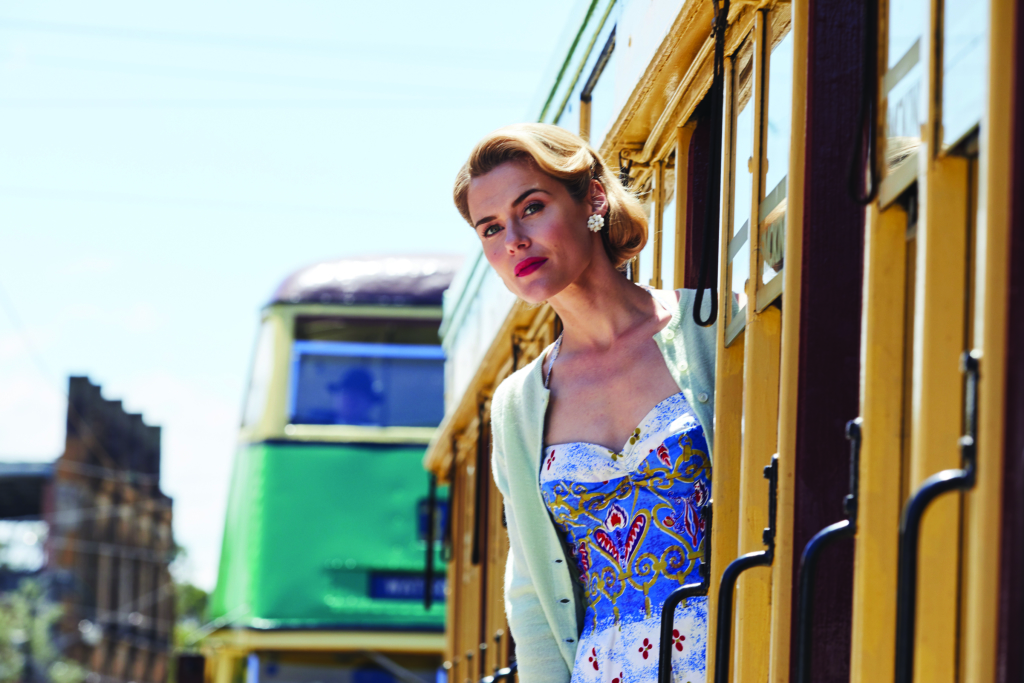
Is this a cop-out? Nostalgia is often characterised as a comforting retreat from scary contemporary realities and into a safe, cosy past, but, as cultural critic Myke Bartlett writes of the 1980s-nostalgic TV series Stranger Things, social critique of the past is itself a mode of nostalgia: ‘When we look backwards, we also identify the values and norms that either align with our own, or provide a welcome, mourned-for alternative.’ Some recent period dramas flatter the progressive contemporary viewer by dramatising the harm caused by repressive past social structures and romanticising protagonists who bravely break the rules. Bartlett observes that such ‘cognitive dissonance – in which we need the past to be at once the same and different to the present – is undoubtedly part of the allure’.[10]Myke Bartlett, ‘Rose-coloured Rear-view: Stranger Things and the Lure of a False Past’, Screen Education, no. 85, 2017, pp. 22, 23.
By comparison, Ladies in Black seems ‘problematic’ because it invites viewers to relax into its charmingly confected mise en scène, sharing its titular characters’ hope and longing. But literary critic Svetlana Boym argues that ‘longing and critical thinking are not opposed to one another, as affective memories do not absolve one from compassion, judgment or critical reflection’.[11]Svetlana Boym, The Future of Nostalgia, Basic Books, New York, 2001, p. 50. I have previously argued that demonising the past always serves the political ideologies of the present; conversely, reflecting on our uncertain relationship to the past can enable an ethical reinterrogation of present truisms.[12]See Mel Campbell, ‘The Political Power of Nostalgia’, Crikey, 7 December 2010, <https://www.crikey.com.au/2010/12/07/mel-campbell-the-political-power-of-nostalgia/>, accessed 24 October 2018. What makes Ladies in Black nostalgic is its optimism for a bright future that we now know never really eventuated; in particular, today’s public discourse on feminism and immigration is nakedly hate-filled.
Yet Ladies in Black truly comes alive in the scenes featuring its migrant characters. The Australia that Milliken calls ‘barren and stagnant’ is, to Magda, Stefan and Rudi, a sun-drenched paradise; shrugging off the trauma of World War II, they are determined to live joyfully. It’s this joy – not our own present disillusionment – that shapes the tone of this film. And, beneath the gloss, Ladies in Black suggests something more subversive: that locally born Australians remain a hapless, complacent people who need to be nudged towards our own desires like fat, milk-drunk babies. Perhaps the dresses are for mourning, after all.
https://www.ladiesinblackmovie.com.au
Endnotes
| 1 | Garry Maddox, ‘Ladies in Black, a Love Letter to Sydney’, The Sydney Morning Herald, 6 September 2018, <https://www.smh.com.au/entertainment/movies/ladies-in-black-a-love-letter-to-sydney-20180828-p500cm.html>, accessed 24 October 2018. |
|---|---|
| 2 | Bruce Beresford, ‘Madeleine and Me’, in Madeleine St John, The Women in Black, Text Publishing, Melbourne, 2009 [1993], p. xv. |
| 3 | ibid., pp. xvi–xvii. |
| 4 | While the title change originally happened in 2015, when Tim Finn adapted the novel for the theatre, Beresford and Milliken’s decision to retain it is nevertheless telling. |
| 5 | See, for example, Glenn Dunks, ‘Ladies in Black Is an Exquisitely Entertaining Story of Romance and Female Empowerment’, Flicks.com.au, 18 September 2018, <https://www.flicks.com.au/reviews/ladies-in-black-is-an-exquisitely-entertaining-story-of-romance-and-female-empowerment/>, accessed 24 October 2018. |
| 6 | Marc Bain, ‘Only Black Is the New Black: A Cultural History of Fashion’s Favorite Shade’, Quartzy, 4 February 2018, <https://qz.com/quartzy/1194798/only-black-is-the-new-black-a-cultural-history-of-fashions-favorite-shade/>, accessed 24 October 2018. |
| 7 | See Dame Zandra Rhodes with Sonnet Stanfill, ‘Why Is the Little Black Dress a Fashion Icon?’, iWonder, BBC, <http://www.bbc.co.uk/guides/z2y4v4j>, accessed 24 October 2018. |
| 8 | See Ruth La Ferla, ‘Love for Sale: The Shopgirl Has a Pop Cultural Moment’, The New York Times, 16 December 2015, <https://www.nytimes.com/2015/12/17/fashion/love-for-sale-the-shopgirl-has-a-pop-cultural-moment.html>, accessed 24 October 2015. |
| 9 | Sue Milliken, quoted in Maddox, op. cit. |
| 10 | Myke Bartlett, ‘Rose-coloured Rear-view: Stranger Things and the Lure of a False Past’, Screen Education, no. 85, 2017, pp. 22, 23. |
| 11 | Svetlana Boym, The Future of Nostalgia, Basic Books, New York, 2001, p. 50. |
| 12 | See Mel Campbell, ‘The Political Power of Nostalgia’, Crikey, 7 December 2010, <https://www.crikey.com.au/2010/12/07/mel-campbell-the-political-power-of-nostalgia/>, accessed 24 October 2018. |
